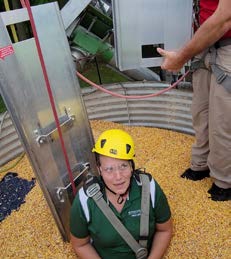
Preventing Death and Injury Through Grain Bin Safety and Rescue Training for Farmers and First Responders
DOWNLOADJuly 9, 2024 - Michigan State University Extension
Impacts
- 42.5% farm injuries involve the upper extremities.¹
- 70% of agricultural-related injuries are underreported.²
- 44 grain bin rescue certificates of completion were awarded by the National Education Center for Agricultural Safety (www.necasag.org) to first responders from 12 counties.
- 43 farmers from 16 counties participated in the manure pit and grain bin safety programs.
Priority Areas
The agriculture industry is one of the most hazardous industries. Farm operators and workers have a high rate of work-related fatalities. The Occupational and Environmental Medicine Division (https://oem.msu.edu/) at Michigan State University (MSU) reported 388 work-related farm injuries in Michigan in 2021. There were an additional 19 agricultural fatalities. Farm-related injuries, like all occupational injuries, are potentially preventable. MSU Extension, Michigan Farm Bureau, Michigan Farm Bureau Insurance and Michigan Corn sponsored a confined space grain bin safety and rescue program designed to reduce injury and death from grain engulfment.
References and Acknowledgements
- Michigan State University. (2023). Tracking work-related farm injuries in Michigan. https://oem.msu.edu/images/Data_Fact_Sheets/SummaryTrackingFarm%20Injuries_3_21_2023.pdf
- Harduar Morano, L., & Rosenman, K. D. (2024).Non-fatal work-related farm injuries occurring to Michigan adults and youths. Journal of Agromedicine. 29(2):155-161. doi:10.1080/1059924X.2023.2281530
Any opinions, findings, conclusions or recommendations expressed in this publication are those of the authors and do not necessarily reflect the view of the U.S. Department of Agriculture.

Grain Bin Safety and Rescue Training Programs
The grain bin safety and rescue programs were held at Michigan Agricultural Commodities in Brown City, Michigan, the Clinton County Fairgrounds in St. Johns, Michigan, and the Berlin Fair in Marne, Michigan. The safety programs were designed for farmers, while the rescue program was specifically designed for first responders. For the grain bin safety programs, grain bin extraction was demonstrated once so everyone could see how it was done. For the grain bin rescue training, grain bin extraction was demonstrated multiple times so every first responder got hands-on experience in extracting someone from the grain.
First responders also learned how to cut into a grain bin without making it topple over to one side. First responders gave very positive verbal feedback on the training they received and a plea to do more agriculture rescue programs. Each first responder received a certificate upon completion of the course. The instructors for the safety and rescue training programs were with the National Education Center for Agricultural Safety (NECAS). Both instructors were paramedics and first responders in their local fire department.

After going through the Clinton County training, a participant was so motivated to purchase a grain rescue tube for his township emergency response personnel that he began contacting local growers and agribusinesses to raise the money to purchase one. However, when AgroLiquid found out about his efforts, they jumped in and purchased the grain rescue tube. It is housed at the St. Johns Fire Department and is available for use by first responders throughout Clinton County.




 Print
Print Email
Email




